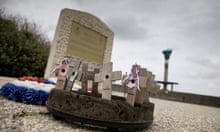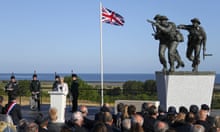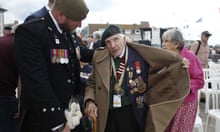What was D-day?
D-day was an invasion of France by allied forces as part of the process of ending the second world war in Europe. It was codenamed Operation Neptune, and it aimed to push Nazi Germany out of the occupied country.
Five beaches in northern France, codenamed Omaha, Utah, Juno, Sword and Gold, were the main targets for landing a large number of troops by sea.
At 10pm on 5 June 1944, troops began departing from British shores to head across the Channel. Five assault groups set sail under darkness in an armada of about 7,000 vessels.
Just after midnight on 6 June, aerial bombardment of enemy positions on the Normandy coast began. That night, more than 5,300 tonnes of bombs were dropped. Special operations troops were parachuted into the country to attack bridges and secure vital infrastructure targets before the landings. They also sent information about German positions back by pigeon.
After anchoring off the coast of France for a couple of hours, US troops landed on Omaha and Utah beaches at about 6:30am. About an hour later Canadian forces landed at Juno, and British troops landed at Gold and Sword.
US troops faced stiff German resistance at Omaha beach in particular, and were pinned down for several hours, suffering heavy losses.
5 June had been chosen as the original date, with the expectation that a full moon, calm waters and a low tide would aid the landing of the troops. But when a storm was forecast, one of the most complex combined air, sea and land military operations ever to be attempted was delayed 24 hours on the advice of meteorologists.
How was the plan kept secret?
Despite involving a large number of troops, keeping D-day secret was vital to the success of the operation. A disinformation campaign had led the Germans to believe that Operation Fortitude was the main plan for the allies to invade the continent, via a two-pronged attack involving Norway and Calais. Even once the D-day landings had begun, German commanders were convinced they were just a diversionary tactic before the real invasion.
The public had also been kept in the dark until the operation had begun. On the day, at 9am, Gen Dwight Eisenhower issued a communique announcing that the invasion had begun. Winston Churchill addressed the House of Commons in London at noon, saying: “So far the commanders who are engaged report that everything is proceeding according to plan. And what a plan!”
At 9pm, King George VI addressed the British public in a broadcast, describing the operation as a “fight to win the final victory for the good cause”. By midnight the allied forces had full control of the beaches, and the push into occupied France was under way.
Why is it called D-day?
D-day has come to be associated with this particular invasion plan. Some say the name refers to “departed date” or “disembarkation day”, but the D in D-day actually has no particular significance to Operation Neptune.
It was common practice in the military to make plans that used the term, where the D stands for the day when operations commenced. Relative dates like D-1 for the day before a campaign and D+1 for the day after it started were also used. Military planners also set H-hour, the time at which a plan was to begin.
What happened next?
By the end of the day, the allies had disembarked more than 135,000 men and 10,000 vehicles on to the beaches, and established bridgeheads of varying depths along the Normandy coastline. This came at the cost of 4,400 allied troops being killed, with thousands more injured or missing. There were also heavy casualties among German troops and French civilians.
Fierce fighting continued in the area until August. The ongoing plan relied on landing more and more troops into France, faster than the Germans could reinforce their positions. By 19 August, the allied forces had pushed down far enough to begin the battle to liberate Paris.
German troops surrendered the French capital on 25 August 1944, two and a half months after D-day.









